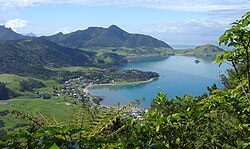Whangarei District
Territorial authority district in Northland, New Zealand From Wikipedia, the free encyclopedia
Territorial authority district in Northland, New Zealand From Wikipedia, the free encyclopedia
Whangarei District is a territorial authority district in the Northland Region of New Zealand that is governed by the Whangarei District Council. The district is made up in area largely by rural land, and includes a fifth of the Northland Region. It extends southwards to the southern end of Bream Bay, northwards to Whangaruru and almost to the Bay of Islands, and westwards up the Mangakahia River valley past Pakotai and almost to Waipoua Forest. It includes the Hen and Chicken Islands and the Poor Knights Islands.
Whangarei District | |
|---|---|
 Mt Lion at the Whangarei Heads as viewed from Mt Manaia | |
 Whangarei district within the North Island | |
| Country | New Zealand |
| Region | Northland |
| District | Whangarei District Council |
| Wards | Māori Bream Bay Hikurangi-Coastal Mangakahia-Maungatapere Whangārei Heads Whangārei Urban |
| Local hapū | Ngāti Hine Ngāti Wai Patuharakeke Te Parawhau |
| Seat | Whangārei |
| Government | |
| • Mayor | Vince Cocurullo[1] |
| • Deputy Mayor | Phil Halse [2] |
| • Territorial authority | Whangarei District Council |
| Area | |
• Total | 2,855 km2 (1,102 sq mi) |
| • Land | 2,711.44 km2 (1,046.89 sq mi) |
| Population | |
• Estimate (June 2024) | 102,200 |
| Postcode(s) | |
The principal urban area and district seat is the city of Whangārei. Other towns include Hūkerenui, Hikurangi, Titoki, Portland, Ruakākā and Waipu. The district population was 102,200 in June 2024.[4]
The district contains beaches such as Ngunguru, game fishing at Tutukaka, a variety of beaches along Whangārei Harbour, as well as Matakohe or Limestone Island in the Harbour, now subject to ecological restoration. The main airport for the district is Whangarei Airport.
Whangarei District covers 2,711.44 km2 (1,046.89 sq mi)[5] and had an estimated population of 102,200 as of June 2024,[4] with a population density of 38 people per km2.
Whangarei District had a population of 96,678 in the 2023 New Zealand census, an increase of 5,718 people (6.3%) since the 2018 census, and an increase of 19,683 people (25.6%) since the 2013 census. There were 47,211 males, 49,218 females and 252 people of other genders in 35,535 dwellings.[8] 2.6% of people identified as LGBTIQ+. The median age was 41.6 years (compared with 38.1 years nationally). There were 19,140 people (19.8%) aged under 15 years, 15,465 (16.0%) aged 15 to 29, 41,829 (43.3%) aged 30 to 64, and 20,244 (20.9%) aged 65 or older.[6]
People could identify as more than one ethnicity. The results were 76.3% European (Pākehā); 31.4% Māori; 4.5% Pasifika; 6.4% Asian; 0.7% Middle Eastern, Latin American and African New Zealanders (MELAA); and 2.3% other, which includes people giving their ethnicity as "New Zealander". English was spoken by 97.0%, Māori language by 7.5%, Samoan by 0.3% and other languages by 8.1%. No language could be spoken by 2.0% (e.g. too young to talk). New Zealand Sign Language was known by 0.6%. The percentage of people born overseas was 18.4, compared with 28.8% nationally.
Religious affiliations were 30.4% Christian, 1.0% Hindu, 0.3% Islam, 2.6% Māori religious beliefs, 0.5% Buddhist, 0.6% New Age, 0.1% Jewish, and 1.3% other religions. People who answered that they had no religion were 55.8%, and 7.6% of people did not answer the census question.
Of those at least 15 years old, 11,343 (14.6%) people had a bachelor's or higher degree, 43,365 (55.9%) had a post-high school certificate or diploma, and 19,200 (24.8%) people exclusively held high school qualifications. The median income was $36,500, compared with $41,500 nationally. 6,681 people (8.6%) earned over $100,000 compared to 12.1% nationally. The employment status of those at least 15 was that 35,892 (46.3%) people were employed full-time, 10,545 (13.6%) were part-time, and 2,256 (2.9%) were unemployed.[6]

| Name | Area (km2) | Population | Density (per km2) | Dwellings | Median age | Median income |
|---|---|---|---|---|---|---|
| Mangakahia-Maungatapere General Ward | 582.45 | 7,593 | 13 | 2,595 | 43.2 years | $41,800[9] |
| Hikurangi-Coastal General Ward | 987.46 | 13,704 | 14 | 4,839 | 43.2 years | $38,200[10] |
| Whangārei Heads General Ward | 271.77 | 7,743 | 28 | 2,925 | 48.7 years | $39,300[11] |
| Whangārei Urban General Ward | 56.50 | 52,089 | 922 | 19,215 | 38.0 years | $35,100[12] |
| Bream Bay General Ward | 813.27 | 15,552 | 19 | 5,967 | 48.4 years | $36,500[13] |
| New Zealand | 38.1 years | $41,500 |
Whangarei District Council was formed by an amalgamation of Whangarei City Council, Whangarei County Council and Hikurangi Town Council as part of New Zealand's 1989 local government reforms.
There is a district-wide Māori ward and five general wards: Whangārei Urban in the city, Hikurangi-Coastal in the north, Mangakahia-Maungatapere inland to the west, Bream Bay in the south, and Whangārei Heads to the east of the city.
Seamless Wikipedia browsing. On steroids.
Every time you click a link to Wikipedia, Wiktionary or Wikiquote in your browser's search results, it will show the modern Wikiwand interface.
Wikiwand extension is a five stars, simple, with minimum permission required to keep your browsing private, safe and transparent.